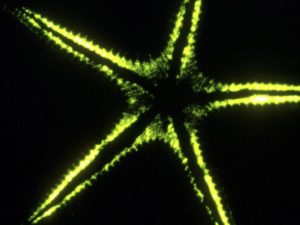
What is bioluminescence?
When people mention on the meaning of luminescence, the first thing we can relate and remind might be the example of firefly butts that lit up in the dark. This phenomenon is called bioluminescence which the organisms produce visible light and is generated by a chemical reaction involving Luciferin, which is a substrate, Luciferase, an enzyme, ATP, and oxygen. The firefly can control the length and duration of the light up, by controlling the oxygen amount that it takes in. The existences of bioluminescent cells or organelle in the firefly butts are the main contributing source of light. In fact, bioluminescence is an ability found only in the deep sea creatures, with the exception to fireflies which also possess this unique ability. For example, in the deep blue sea, probably the ugliest animal in the world which can also be found in the movie Finding Nemo, the Angler fish, is known to depend on symbiosis relationship with bioluminescent bacteria near its head to lure and hunt the prey in the deep sea
Phosphorescence vs. Fluorescence
The phosphorescence paint is used on the glow-in-dark toy, T-shirts and poster. People often confuse bioluminescence with fluorescence, as they are both almost similar. Phosphorescence is different as it is able to re-emit light for longer period of time while the fluorescence is dependent on the absorption of light and does not persist when the excitation source is removed. The perfect example of fluorescence in our everyday use is the highlighter pen ink.
Luminescent bacteria
The most common bioluminescent bacteria are Vibrio harveyi and Vibrio fischeri. There are many uses of luminescent bacteria. Scientist commonly use Vibrio fischeri bacteria on the photobacterium agar media to detect and determine acute toxicity of a certain subject.
Bioluminescent properties conferring advantages to animals and science

The seed shrimp contains much luciferin and secretes the luminescent to dash and surprise away the predator
Application of Luminescent Bacteria
The detection of contamination in water can be expensive and time-consuming by when chemical specific assays are utilized. Besides that, the bioluminescent bacteria can also be utilized to detect many water and environmental contaminants which includes pesticides and herbicides, ZnSO4, CuSO4, HgCl2, and NaNO3. Therefore, a suitable method which is rapid, versatile, cost-effective and simple to determine the presence of contamination is very much needed to improve the quality and purity of water. It can be done by visual inspection on the inhibition of metabolic activity and the reduction bioluminescence intensity of V. fischeri. This is to pre-determine whether there is a presence of toxic chemical contaminants.
Luminescent bacteria named Vibrio harveyi is a natural marine microflora and this bacterium is associated with the mortality rate of larval shrimp in penaeid shrimp hatcheries. A study was conducted using this bacteria in order detect heavy metal in water sources.







